IRIS SCANNER IN AIRPORTS
VerifiedAdded on 2023/03/17
|11
|2954
|78
AI Summary
An IRIS scanner is a technology used for detecting recognition of an individual's identity. This report discusses the results and findings of a research on IRIS scanning in airports, including its advantages, issues faced, and lessons learnt.
Contribute Materials
Your contribution can guide someone’s learning journey. Share your
documents today.
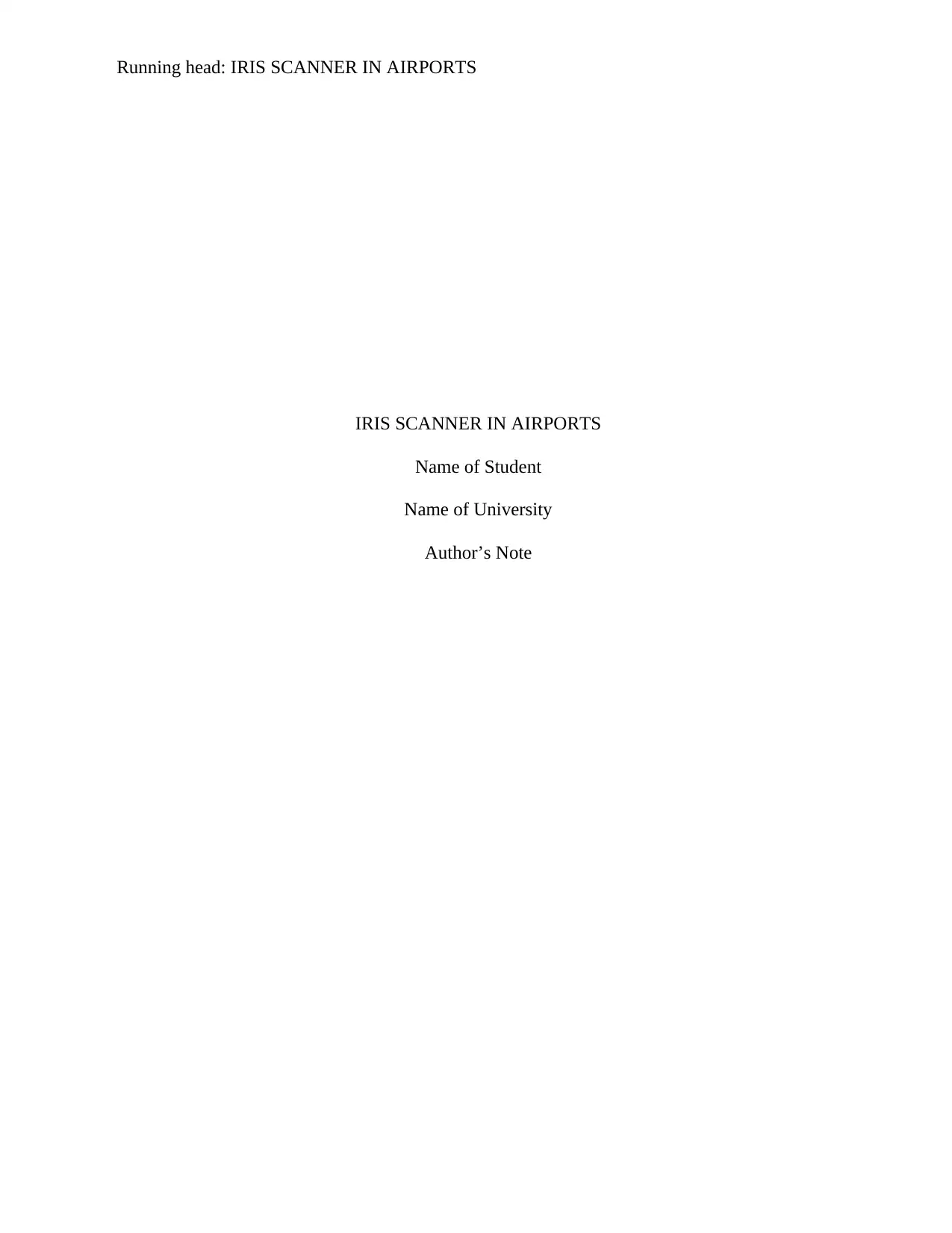
Running head: IRIS SCANNER IN AIRPORTS
IRIS SCANNER IN AIRPORTS
Name of Student
Name of University
Author’s Note
IRIS SCANNER IN AIRPORTS
Name of Student
Name of University
Author’s Note
Secure Best Marks with AI Grader
Need help grading? Try our AI Grader for instant feedback on your assignments.

1IRIS SCANNER IN AIRPORTS
Table of Contents
Introduction......................................................................................................................................2
Results and findings.........................................................................................................................2
IRIS scanning...............................................................................................................................3
Why is ISIR scanning helpful?....................................................................................................4
Why are the issues faced due to iris scanners?............................................................................4
Conclusion.......................................................................................................................................5
Lessons learnt..................................................................................................................................6
References........................................................................................................................................9
Table of Contents
Introduction......................................................................................................................................2
Results and findings.........................................................................................................................2
IRIS scanning...............................................................................................................................3
Why is ISIR scanning helpful?....................................................................................................4
Why are the issues faced due to iris scanners?............................................................................4
Conclusion.......................................................................................................................................5
Lessons learnt..................................................................................................................................6
References........................................................................................................................................9
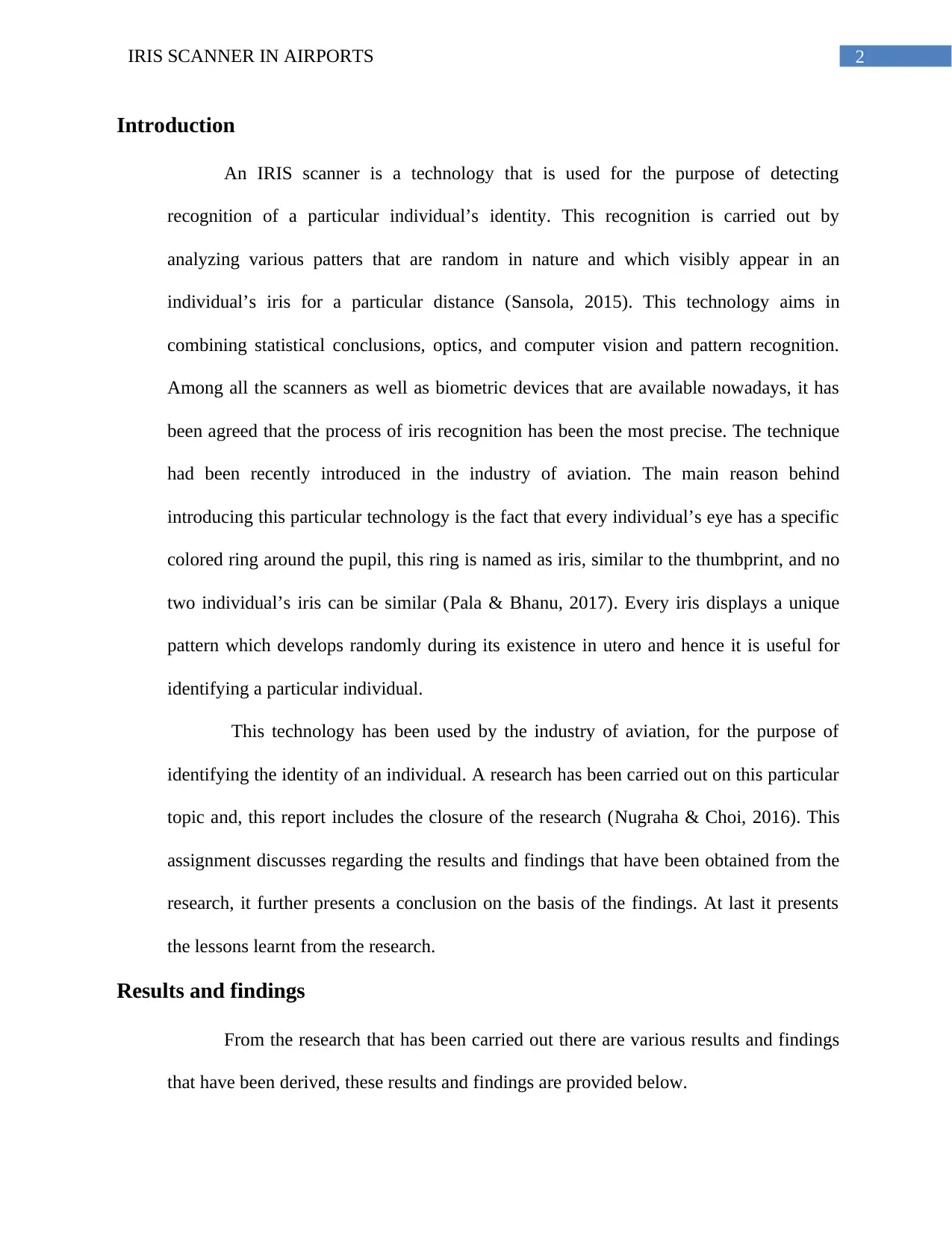
2IRIS SCANNER IN AIRPORTS
Introduction
An IRIS scanner is a technology that is used for the purpose of detecting
recognition of a particular individual’s identity. This recognition is carried out by
analyzing various patters that are random in nature and which visibly appear in an
individual’s iris for a particular distance (Sansola, 2015). This technology aims in
combining statistical conclusions, optics, and computer vision and pattern recognition.
Among all the scanners as well as biometric devices that are available nowadays, it has
been agreed that the process of iris recognition has been the most precise. The technique
had been recently introduced in the industry of aviation. The main reason behind
introducing this particular technology is the fact that every individual’s eye has a specific
colored ring around the pupil, this ring is named as iris, similar to the thumbprint, and no
two individual’s iris can be similar (Pala & Bhanu, 2017). Every iris displays a unique
pattern which develops randomly during its existence in utero and hence it is useful for
identifying a particular individual.
This technology has been used by the industry of aviation, for the purpose of
identifying the identity of an individual. A research has been carried out on this particular
topic and, this report includes the closure of the research (Nugraha & Choi, 2016). This
assignment discusses regarding the results and findings that have been obtained from the
research, it further presents a conclusion on the basis of the findings. At last it presents
the lessons learnt from the research.
Results and findings
From the research that has been carried out there are various results and findings
that have been derived, these results and findings are provided below.
Introduction
An IRIS scanner is a technology that is used for the purpose of detecting
recognition of a particular individual’s identity. This recognition is carried out by
analyzing various patters that are random in nature and which visibly appear in an
individual’s iris for a particular distance (Sansola, 2015). This technology aims in
combining statistical conclusions, optics, and computer vision and pattern recognition.
Among all the scanners as well as biometric devices that are available nowadays, it has
been agreed that the process of iris recognition has been the most precise. The technique
had been recently introduced in the industry of aviation. The main reason behind
introducing this particular technology is the fact that every individual’s eye has a specific
colored ring around the pupil, this ring is named as iris, similar to the thumbprint, and no
two individual’s iris can be similar (Pala & Bhanu, 2017). Every iris displays a unique
pattern which develops randomly during its existence in utero and hence it is useful for
identifying a particular individual.
This technology has been used by the industry of aviation, for the purpose of
identifying the identity of an individual. A research has been carried out on this particular
topic and, this report includes the closure of the research (Nugraha & Choi, 2016). This
assignment discusses regarding the results and findings that have been obtained from the
research, it further presents a conclusion on the basis of the findings. At last it presents
the lessons learnt from the research.
Results and findings
From the research that has been carried out there are various results and findings
that have been derived, these results and findings are provided below.
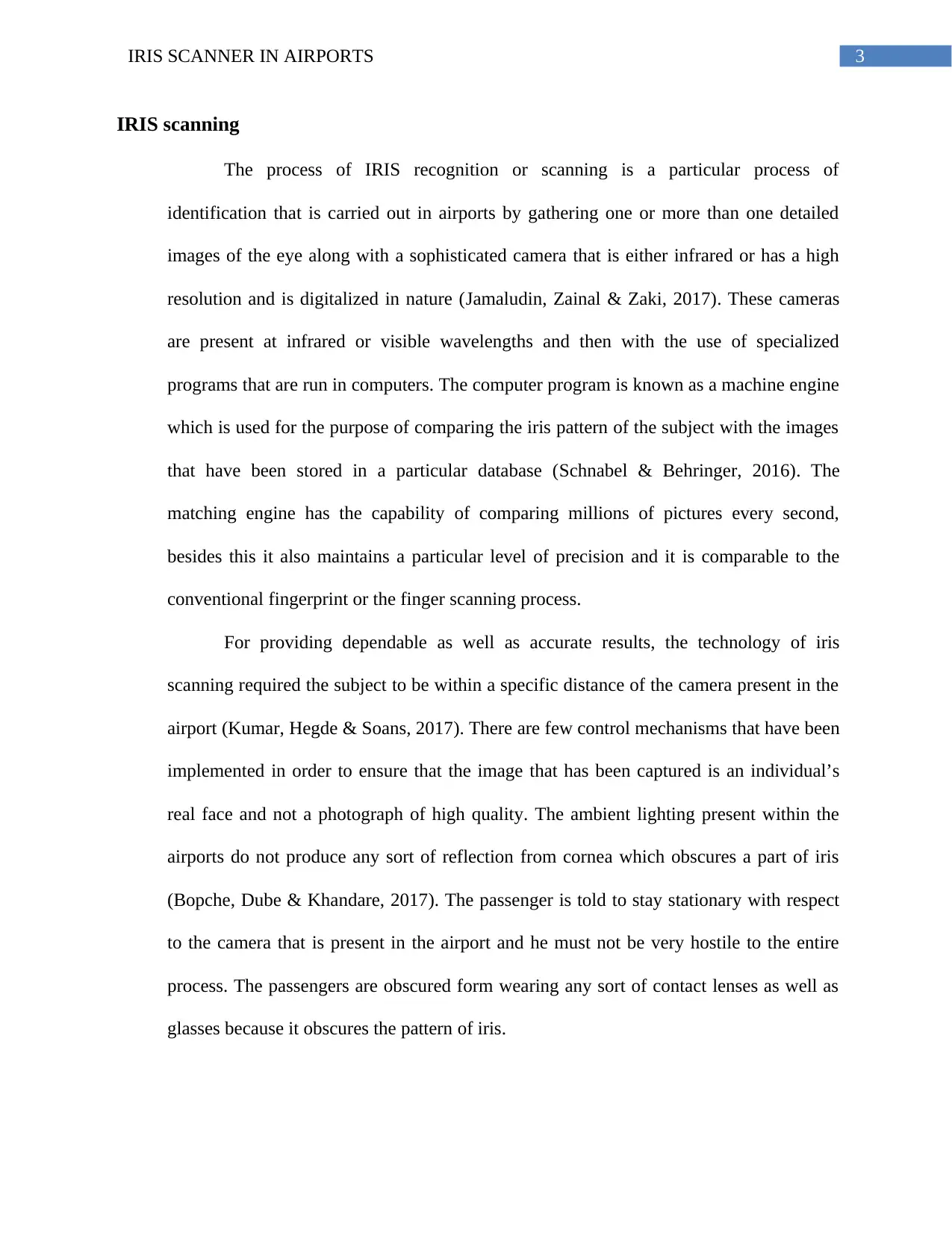
3IRIS SCANNER IN AIRPORTS
IRIS scanning
The process of IRIS recognition or scanning is a particular process of
identification that is carried out in airports by gathering one or more than one detailed
images of the eye along with a sophisticated camera that is either infrared or has a high
resolution and is digitalized in nature (Jamaludin, Zainal & Zaki, 2017). These cameras
are present at infrared or visible wavelengths and then with the use of specialized
programs that are run in computers. The computer program is known as a machine engine
which is used for the purpose of comparing the iris pattern of the subject with the images
that have been stored in a particular database (Schnabel & Behringer, 2016). The
matching engine has the capability of comparing millions of pictures every second,
besides this it also maintains a particular level of precision and it is comparable to the
conventional fingerprint or the finger scanning process.
For providing dependable as well as accurate results, the technology of iris
scanning required the subject to be within a specific distance of the camera present in the
airport (Kumar, Hegde & Soans, 2017). There are few control mechanisms that have been
implemented in order to ensure that the image that has been captured is an individual’s
real face and not a photograph of high quality. The ambient lighting present within the
airports do not produce any sort of reflection from cornea which obscures a part of iris
(Bopche, Dube & Khandare, 2017). The passenger is told to stay stationary with respect
to the camera that is present in the airport and he must not be very hostile to the entire
process. The passengers are obscured form wearing any sort of contact lenses as well as
glasses because it obscures the pattern of iris.
IRIS scanning
The process of IRIS recognition or scanning is a particular process of
identification that is carried out in airports by gathering one or more than one detailed
images of the eye along with a sophisticated camera that is either infrared or has a high
resolution and is digitalized in nature (Jamaludin, Zainal & Zaki, 2017). These cameras
are present at infrared or visible wavelengths and then with the use of specialized
programs that are run in computers. The computer program is known as a machine engine
which is used for the purpose of comparing the iris pattern of the subject with the images
that have been stored in a particular database (Schnabel & Behringer, 2016). The
matching engine has the capability of comparing millions of pictures every second,
besides this it also maintains a particular level of precision and it is comparable to the
conventional fingerprint or the finger scanning process.
For providing dependable as well as accurate results, the technology of iris
scanning required the subject to be within a specific distance of the camera present in the
airport (Kumar, Hegde & Soans, 2017). There are few control mechanisms that have been
implemented in order to ensure that the image that has been captured is an individual’s
real face and not a photograph of high quality. The ambient lighting present within the
airports do not produce any sort of reflection from cornea which obscures a part of iris
(Bopche, Dube & Khandare, 2017). The passenger is told to stay stationary with respect
to the camera that is present in the airport and he must not be very hostile to the entire
process. The passengers are obscured form wearing any sort of contact lenses as well as
glasses because it obscures the pattern of iris.
Secure Best Marks with AI Grader
Need help grading? Try our AI Grader for instant feedback on your assignments.
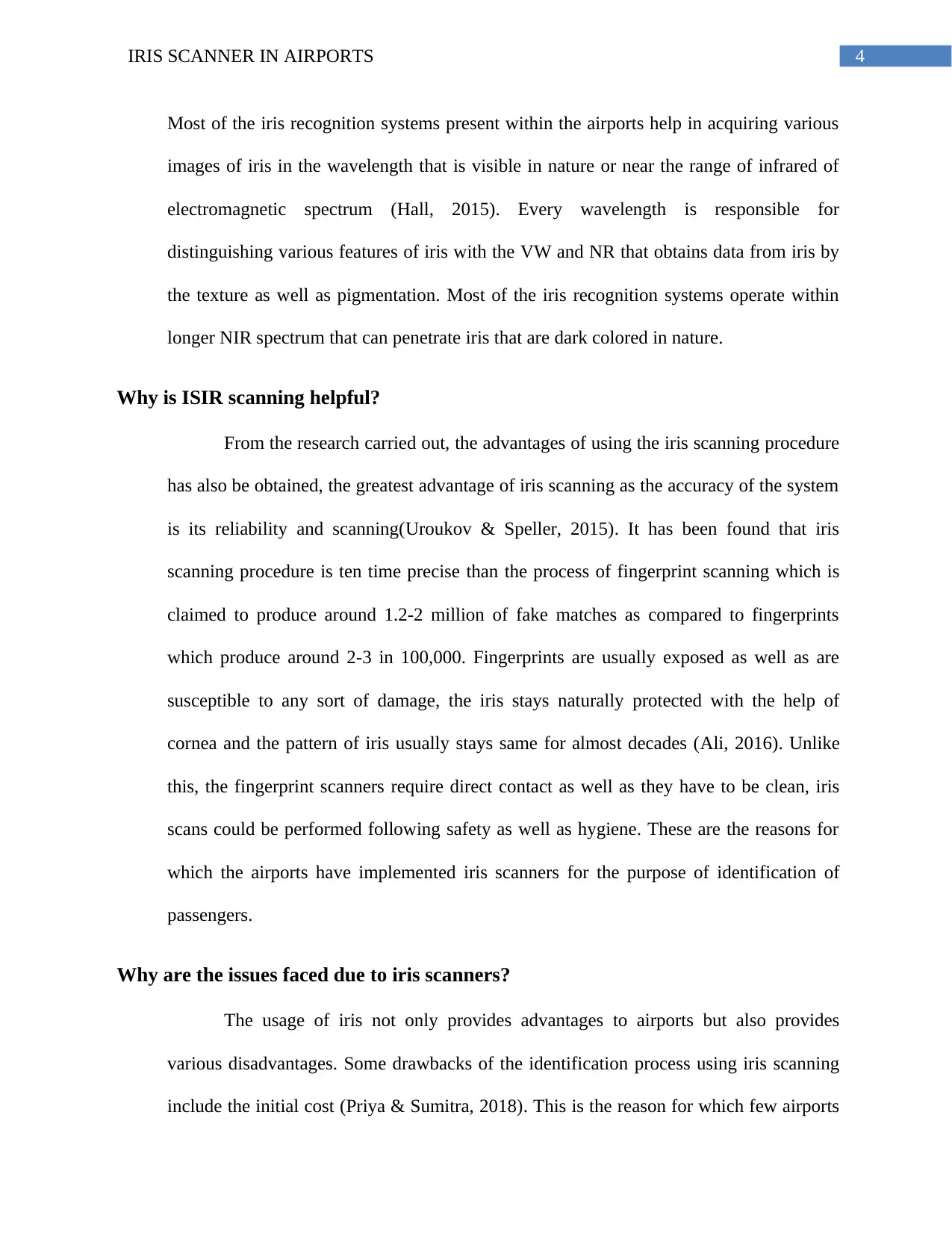
4IRIS SCANNER IN AIRPORTS
Most of the iris recognition systems present within the airports help in acquiring various
images of iris in the wavelength that is visible in nature or near the range of infrared of
electromagnetic spectrum (Hall, 2015). Every wavelength is responsible for
distinguishing various features of iris with the VW and NR that obtains data from iris by
the texture as well as pigmentation. Most of the iris recognition systems operate within
longer NIR spectrum that can penetrate iris that are dark colored in nature.
Why is ISIR scanning helpful?
From the research carried out, the advantages of using the iris scanning procedure
has also be obtained, the greatest advantage of iris scanning as the accuracy of the system
is its reliability and scanning(Uroukov & Speller, 2015). It has been found that iris
scanning procedure is ten time precise than the process of fingerprint scanning which is
claimed to produce around 1.2-2 million of fake matches as compared to fingerprints
which produce around 2-3 in 100,000. Fingerprints are usually exposed as well as are
susceptible to any sort of damage, the iris stays naturally protected with the help of
cornea and the pattern of iris usually stays same for almost decades (Ali, 2016). Unlike
this, the fingerprint scanners require direct contact as well as they have to be clean, iris
scans could be performed following safety as well as hygiene. These are the reasons for
which the airports have implemented iris scanners for the purpose of identification of
passengers.
Why are the issues faced due to iris scanners?
The usage of iris not only provides advantages to airports but also provides
various disadvantages. Some drawbacks of the identification process using iris scanning
include the initial cost (Priya & Sumitra, 2018). This is the reason for which few airports
Most of the iris recognition systems present within the airports help in acquiring various
images of iris in the wavelength that is visible in nature or near the range of infrared of
electromagnetic spectrum (Hall, 2015). Every wavelength is responsible for
distinguishing various features of iris with the VW and NR that obtains data from iris by
the texture as well as pigmentation. Most of the iris recognition systems operate within
longer NIR spectrum that can penetrate iris that are dark colored in nature.
Why is ISIR scanning helpful?
From the research carried out, the advantages of using the iris scanning procedure
has also be obtained, the greatest advantage of iris scanning as the accuracy of the system
is its reliability and scanning(Uroukov & Speller, 2015). It has been found that iris
scanning procedure is ten time precise than the process of fingerprint scanning which is
claimed to produce around 1.2-2 million of fake matches as compared to fingerprints
which produce around 2-3 in 100,000. Fingerprints are usually exposed as well as are
susceptible to any sort of damage, the iris stays naturally protected with the help of
cornea and the pattern of iris usually stays same for almost decades (Ali, 2016). Unlike
this, the fingerprint scanners require direct contact as well as they have to be clean, iris
scans could be performed following safety as well as hygiene. These are the reasons for
which the airports have implemented iris scanners for the purpose of identification of
passengers.
Why are the issues faced due to iris scanners?
The usage of iris not only provides advantages to airports but also provides
various disadvantages. Some drawbacks of the identification process using iris scanning
include the initial cost (Priya & Sumitra, 2018). This is the reason for which few airports

5IRIS SCANNER IN AIRPORTS
have not been able to implement this technology. There had been some trials that were
carried out in the process of testing and they have proved to provide numerous false
matches. Various aviation companies have also reported privacy concerns that have been
faced by the usage of this technology (Barcenas & Karabina, 2017). They had claimed
that in future the iris technology might be developed such that they would be allowed to
track people without even their consent or knowledge. Privacy and security are some
more concerns that have been raised. Passengers who support biometric technology said
that it makes things such as computer as well as ATM access secured as compared to the
traditional and vulnerable technologies like passwords as well as pin numbers (Ciuffo &
Weiss, 2017). Critics had highlighted various risks of criminals who have been successful
in compromising iris scanning security; they have done it either by the usage of high
resolution photos of people’s eyes or through a dead person’s eyeballs. The recent iris
scanning system had tried to get this around with the help of detecting an individual’s eye
movements or keeping a track on how an individual’s eyes change in various lightening
conditions.
Conclusion
From the above discussion, it can be concluded that the technology of iris
identification is used in various airports for the purpose of identifying passengers; they
also use them to maintain a high level of security for national identity cards, traditional
verification as well as passports (Suresh, Subramani & Thilak, 2017). Various airports
that are present all over the world have been using the iris scanners as well as recognition
technology. Presently they have been proven to be the most precise sort of modern
biometrics that is available. Security in airports has been a matter of immense
have not been able to implement this technology. There had been some trials that were
carried out in the process of testing and they have proved to provide numerous false
matches. Various aviation companies have also reported privacy concerns that have been
faced by the usage of this technology (Barcenas & Karabina, 2017). They had claimed
that in future the iris technology might be developed such that they would be allowed to
track people without even their consent or knowledge. Privacy and security are some
more concerns that have been raised. Passengers who support biometric technology said
that it makes things such as computer as well as ATM access secured as compared to the
traditional and vulnerable technologies like passwords as well as pin numbers (Ciuffo &
Weiss, 2017). Critics had highlighted various risks of criminals who have been successful
in compromising iris scanning security; they have done it either by the usage of high
resolution photos of people’s eyes or through a dead person’s eyeballs. The recent iris
scanning system had tried to get this around with the help of detecting an individual’s eye
movements or keeping a track on how an individual’s eyes change in various lightening
conditions.
Conclusion
From the above discussion, it can be concluded that the technology of iris
identification is used in various airports for the purpose of identifying passengers; they
also use them to maintain a high level of security for national identity cards, traditional
verification as well as passports (Suresh, Subramani & Thilak, 2017). Various airports
that are present all over the world have been using the iris scanners as well as recognition
technology. Presently they have been proven to be the most precise sort of modern
biometrics that is available. Security in airports has been a matter of immense
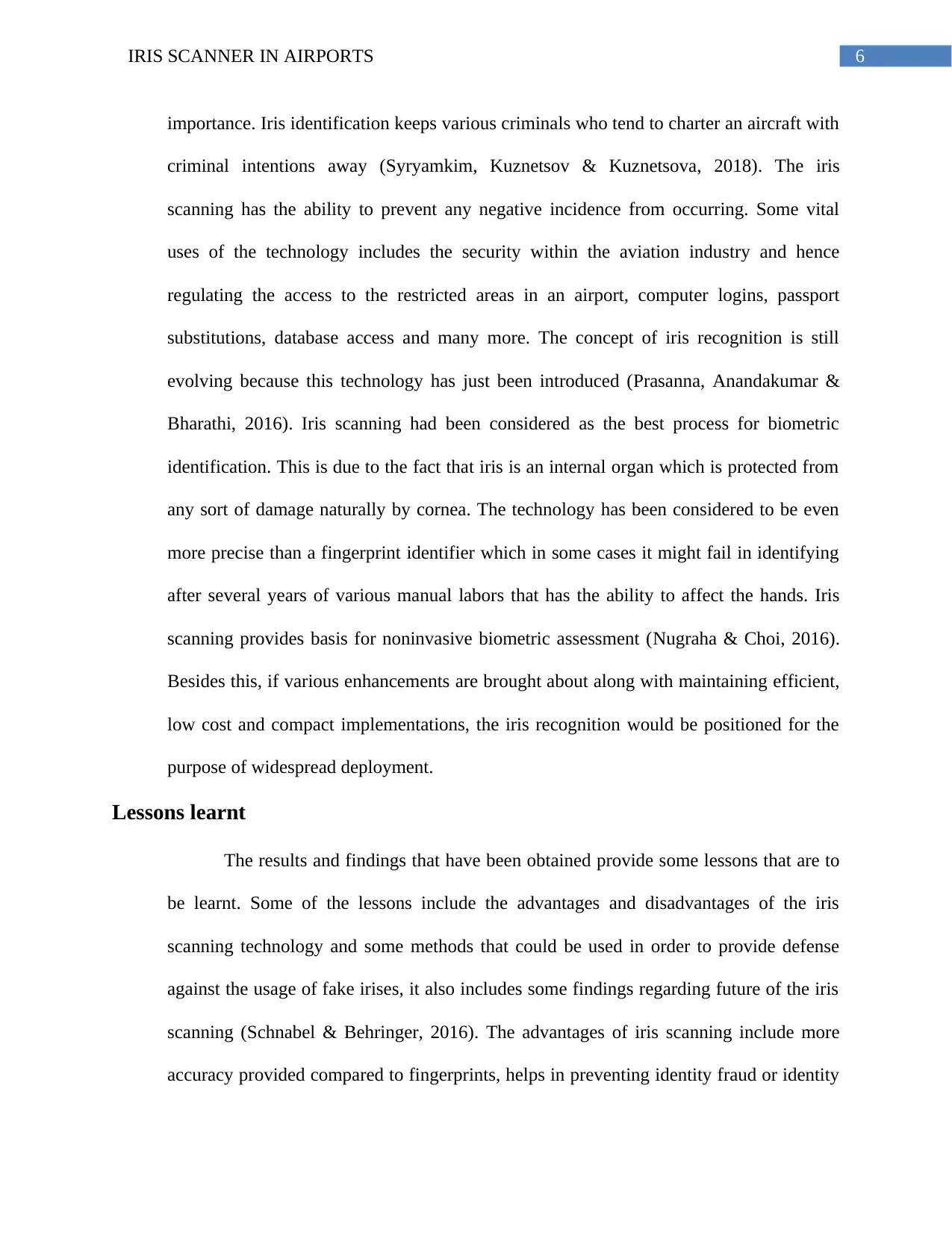
6IRIS SCANNER IN AIRPORTS
importance. Iris identification keeps various criminals who tend to charter an aircraft with
criminal intentions away (Syryamkim, Kuznetsov & Kuznetsova, 2018). The iris
scanning has the ability to prevent any negative incidence from occurring. Some vital
uses of the technology includes the security within the aviation industry and hence
regulating the access to the restricted areas in an airport, computer logins, passport
substitutions, database access and many more. The concept of iris recognition is still
evolving because this technology has just been introduced (Prasanna, Anandakumar &
Bharathi, 2016). Iris scanning had been considered as the best process for biometric
identification. This is due to the fact that iris is an internal organ which is protected from
any sort of damage naturally by cornea. The technology has been considered to be even
more precise than a fingerprint identifier which in some cases it might fail in identifying
after several years of various manual labors that has the ability to affect the hands. Iris
scanning provides basis for noninvasive biometric assessment (Nugraha & Choi, 2016).
Besides this, if various enhancements are brought about along with maintaining efficient,
low cost and compact implementations, the iris recognition would be positioned for the
purpose of widespread deployment.
Lessons learnt
The results and findings that have been obtained provide some lessons that are to
be learnt. Some of the lessons include the advantages and disadvantages of the iris
scanning technology and some methods that could be used in order to provide defense
against the usage of fake irises, it also includes some findings regarding future of the iris
scanning (Schnabel & Behringer, 2016). The advantages of iris scanning include more
accuracy provided compared to fingerprints, helps in preventing identity fraud or identity
importance. Iris identification keeps various criminals who tend to charter an aircraft with
criminal intentions away (Syryamkim, Kuznetsov & Kuznetsova, 2018). The iris
scanning has the ability to prevent any negative incidence from occurring. Some vital
uses of the technology includes the security within the aviation industry and hence
regulating the access to the restricted areas in an airport, computer logins, passport
substitutions, database access and many more. The concept of iris recognition is still
evolving because this technology has just been introduced (Prasanna, Anandakumar &
Bharathi, 2016). Iris scanning had been considered as the best process for biometric
identification. This is due to the fact that iris is an internal organ which is protected from
any sort of damage naturally by cornea. The technology has been considered to be even
more precise than a fingerprint identifier which in some cases it might fail in identifying
after several years of various manual labors that has the ability to affect the hands. Iris
scanning provides basis for noninvasive biometric assessment (Nugraha & Choi, 2016).
Besides this, if various enhancements are brought about along with maintaining efficient,
low cost and compact implementations, the iris recognition would be positioned for the
purpose of widespread deployment.
Lessons learnt
The results and findings that have been obtained provide some lessons that are to
be learnt. Some of the lessons include the advantages and disadvantages of the iris
scanning technology and some methods that could be used in order to provide defense
against the usage of fake irises, it also includes some findings regarding future of the iris
scanning (Schnabel & Behringer, 2016). The advantages of iris scanning include more
accuracy provided compared to fingerprints, helps in preventing identity fraud or identity
Paraphrase This Document
Need a fresh take? Get an instant paraphrase of this document with our AI Paraphraser

7IRIS SCANNER IN AIRPORTS
theft, having very low false positive rates and very low occurrence of false negatives.
Some challenges that are faced by this technology includes the susceptibility to damage
caused by diseases, it is viewed as non user friendly and very intrusive, having high
amount of user as well as operator skills, avoidance received from government as well as
private sectors on the concept of implementing the technology, sometimes easily
breached with the use of high resolution picture which makes it inappropriate for
deploying door security systems.
There are some methods that have been found for the purpose of using in order to
protect the sources from usage of fake eyes. Airports can change ambient lightning at the
time of identification so that the papillary reflex could be verified and the image of the
iris could be recorded at few different diameters of pupil (Kumar, Hegde & Soans, 2017).
They can analyze 2D spatial frequency spectrum of iris image, this could be done for the
crests that are instigated by printer dither arrays which are originate on false iris
interaction lenses and these are commercially available. They can also analyze the
chronological frequency spectrums of double for crests that are caused by the display of
the computer.
Usage of iris analysis in the place of merely monochromatic cameras can be done
for the purpose of distinguishing iris tissue from any other material. Observe the
characteristics such as movements of the eyeball (Hall, 2015). They can also carry out
testing for the purpose of retinal retro reflection; they can also test for the reflections from
the four optical surfaces of eyes in order to verify their shape, position as well as
presence. They can also use 3D imaging such as stereophonic cameras in order to
authenticate the figure as well as position of iris related to the other features of eyes
theft, having very low false positive rates and very low occurrence of false negatives.
Some challenges that are faced by this technology includes the susceptibility to damage
caused by diseases, it is viewed as non user friendly and very intrusive, having high
amount of user as well as operator skills, avoidance received from government as well as
private sectors on the concept of implementing the technology, sometimes easily
breached with the use of high resolution picture which makes it inappropriate for
deploying door security systems.
There are some methods that have been found for the purpose of using in order to
protect the sources from usage of fake eyes. Airports can change ambient lightning at the
time of identification so that the papillary reflex could be verified and the image of the
iris could be recorded at few different diameters of pupil (Kumar, Hegde & Soans, 2017).
They can analyze 2D spatial frequency spectrum of iris image, this could be done for the
crests that are instigated by printer dither arrays which are originate on false iris
interaction lenses and these are commercially available. They can also analyze the
chronological frequency spectrums of double for crests that are caused by the display of
the computer.
Usage of iris analysis in the place of merely monochromatic cameras can be done
for the purpose of distinguishing iris tissue from any other material. Observe the
characteristics such as movements of the eyeball (Hall, 2015). They can also carry out
testing for the purpose of retinal retro reflection; they can also test for the reflections from
the four optical surfaces of eyes in order to verify their shape, position as well as
presence. They can also use 3D imaging such as stereophonic cameras in order to
authenticate the figure as well as position of iris related to the other features of eyes
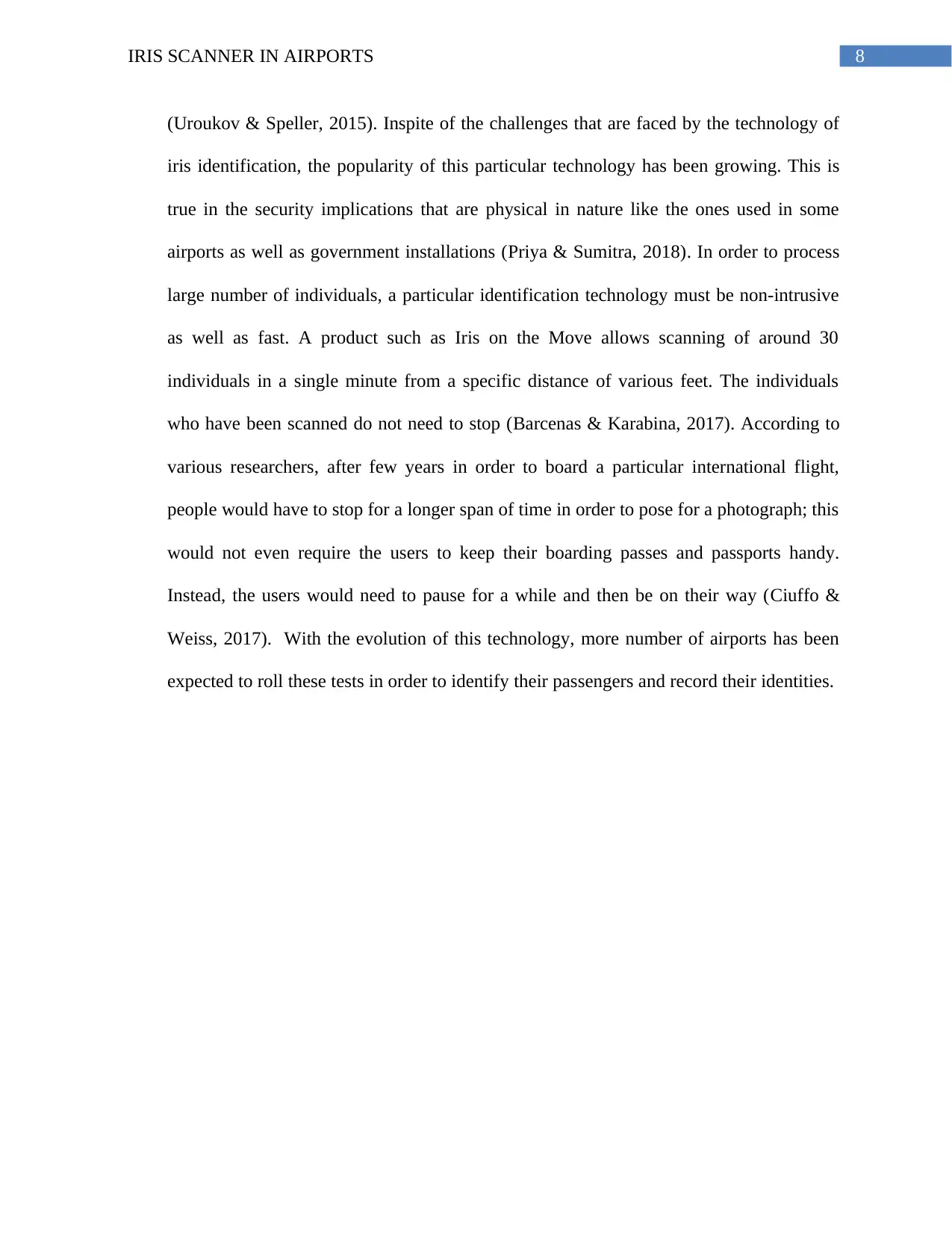
8IRIS SCANNER IN AIRPORTS
(Uroukov & Speller, 2015). Inspite of the challenges that are faced by the technology of
iris identification, the popularity of this particular technology has been growing. This is
true in the security implications that are physical in nature like the ones used in some
airports as well as government installations (Priya & Sumitra, 2018). In order to process
large number of individuals, a particular identification technology must be non-intrusive
as well as fast. A product such as Iris on the Move allows scanning of around 30
individuals in a single minute from a specific distance of various feet. The individuals
who have been scanned do not need to stop (Barcenas & Karabina, 2017). According to
various researchers, after few years in order to board a particular international flight,
people would have to stop for a longer span of time in order to pose for a photograph; this
would not even require the users to keep their boarding passes and passports handy.
Instead, the users would need to pause for a while and then be on their way (Ciuffo &
Weiss, 2017). With the evolution of this technology, more number of airports has been
expected to roll these tests in order to identify their passengers and record their identities.
(Uroukov & Speller, 2015). Inspite of the challenges that are faced by the technology of
iris identification, the popularity of this particular technology has been growing. This is
true in the security implications that are physical in nature like the ones used in some
airports as well as government installations (Priya & Sumitra, 2018). In order to process
large number of individuals, a particular identification technology must be non-intrusive
as well as fast. A product such as Iris on the Move allows scanning of around 30
individuals in a single minute from a specific distance of various feet. The individuals
who have been scanned do not need to stop (Barcenas & Karabina, 2017). According to
various researchers, after few years in order to board a particular international flight,
people would have to stop for a longer span of time in order to pose for a photograph; this
would not even require the users to keep their boarding passes and passports handy.
Instead, the users would need to pause for a while and then be on their way (Ciuffo &
Weiss, 2017). With the evolution of this technology, more number of airports has been
expected to roll these tests in order to identify their passengers and record their identities.

9IRIS SCANNER IN AIRPORTS
References
Ali, M. A. (2016). Biometric identification and recognition for iris using failure rejection rate
(FRR) (Doctoral dissertation, Ph. D. dissertation, Faculty Elect. Eng., Univ. Teknologi
MARA, Shah Alam, Shah Alam).
Barcenas, L., & Karabina, K. (2017). On the Expected Increase of Mobile Transactions
Authenticated Through Biometrics. FAU Undergraduate Research Journal, 6(1), 19.
Bopche, H. S., Dube, S. P., Khandare, P. P., & Pawar, P. D. (2017). Biometric Security System
Using Iris Recognition. International Journal of Electronics, Communication and Soft
Computing Science & Engineering (IJECSCSE), 31-35.
Ciuffo, F., & Weiss, G. M. (2017, October). Smartwatch-based transcription biometrics. In 2017
IEEE 8th Annual Ubiquitous Computing, Electronics and Mobile Communication
Conference (UEMCON) (pp. 145-149). IEEE.
Hall, R. (2015). The transparent traveler: The performance and culture of airport security.
Duke University Press.
Jamaludin, S., Zainal, N., Zaki, W. M. D. W., & Mimi Diyana, W. (2017). GPU implementation
of sub-iris technique in iris recognition system. Pertanika J. Sci. Technol.(2017 in press).
Kumar, A., Hegde, A., & Soans, R. V. (2017, September). Implementation of Optimised
Daugman’s Procedure for Iris Authentication. In 2017 International Conference on
Current Trends in Computer, Electrical, Electronics and Communication (CTCEEC) (pp.
1188-1191). IEEE.
Nugraha, R. A., & Choi, J. (2016). Body Scanners within Airport Security Systems: Security or
Privacy Issue?. The Aviation & Space Journal, 15(3).
References
Ali, M. A. (2016). Biometric identification and recognition for iris using failure rejection rate
(FRR) (Doctoral dissertation, Ph. D. dissertation, Faculty Elect. Eng., Univ. Teknologi
MARA, Shah Alam, Shah Alam).
Barcenas, L., & Karabina, K. (2017). On the Expected Increase of Mobile Transactions
Authenticated Through Biometrics. FAU Undergraduate Research Journal, 6(1), 19.
Bopche, H. S., Dube, S. P., Khandare, P. P., & Pawar, P. D. (2017). Biometric Security System
Using Iris Recognition. International Journal of Electronics, Communication and Soft
Computing Science & Engineering (IJECSCSE), 31-35.
Ciuffo, F., & Weiss, G. M. (2017, October). Smartwatch-based transcription biometrics. In 2017
IEEE 8th Annual Ubiquitous Computing, Electronics and Mobile Communication
Conference (UEMCON) (pp. 145-149). IEEE.
Hall, R. (2015). The transparent traveler: The performance and culture of airport security.
Duke University Press.
Jamaludin, S., Zainal, N., Zaki, W. M. D. W., & Mimi Diyana, W. (2017). GPU implementation
of sub-iris technique in iris recognition system. Pertanika J. Sci. Technol.(2017 in press).
Kumar, A., Hegde, A., & Soans, R. V. (2017, September). Implementation of Optimised
Daugman’s Procedure for Iris Authentication. In 2017 International Conference on
Current Trends in Computer, Electrical, Electronics and Communication (CTCEEC) (pp.
1188-1191). IEEE.
Nugraha, R. A., & Choi, J. (2016). Body Scanners within Airport Security Systems: Security or
Privacy Issue?. The Aviation & Space Journal, 15(3).
Secure Best Marks with AI Grader
Need help grading? Try our AI Grader for instant feedback on your assignments.
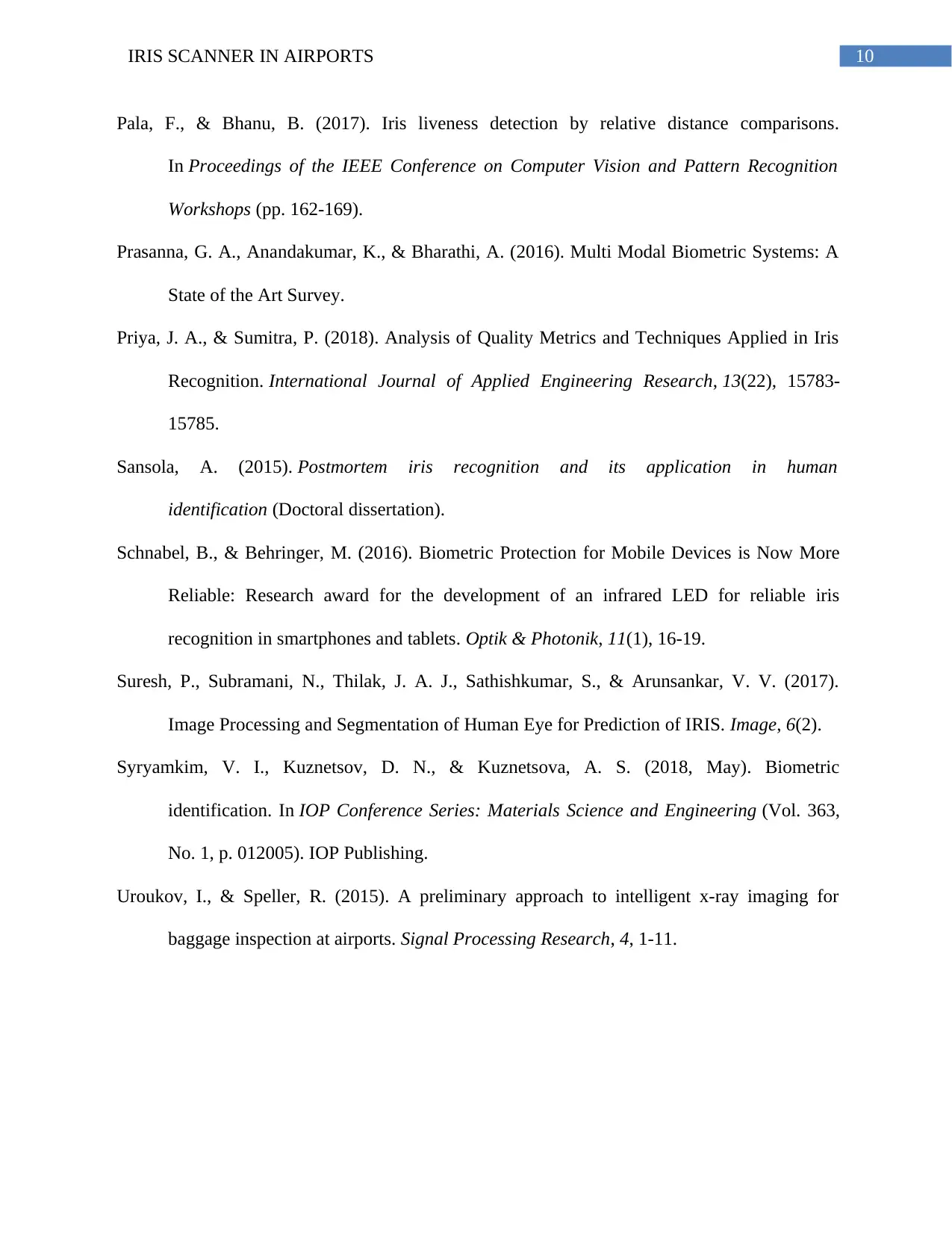
10IRIS SCANNER IN AIRPORTS
Pala, F., & Bhanu, B. (2017). Iris liveness detection by relative distance comparisons.
In Proceedings of the IEEE Conference on Computer Vision and Pattern Recognition
Workshops (pp. 162-169).
Prasanna, G. A., Anandakumar, K., & Bharathi, A. (2016). Multi Modal Biometric Systems: A
State of the Art Survey.
Priya, J. A., & Sumitra, P. (2018). Analysis of Quality Metrics and Techniques Applied in Iris
Recognition. International Journal of Applied Engineering Research, 13(22), 15783-
15785.
Sansola, A. (2015). Postmortem iris recognition and its application in human
identification (Doctoral dissertation).
Schnabel, B., & Behringer, M. (2016). Biometric Protection for Mobile Devices is Now More
Reliable: Research award for the development of an infrared LED for reliable iris
recognition in smartphones and tablets. Optik & Photonik, 11(1), 16-19.
Suresh, P., Subramani, N., Thilak, J. A. J., Sathishkumar, S., & Arunsankar, V. V. (2017).
Image Processing and Segmentation of Human Eye for Prediction of IRIS. Image, 6(2).
Syryamkim, V. I., Kuznetsov, D. N., & Kuznetsova, A. S. (2018, May). Biometric
identification. In IOP Conference Series: Materials Science and Engineering (Vol. 363,
No. 1, p. 012005). IOP Publishing.
Uroukov, I., & Speller, R. (2015). A preliminary approach to intelligent x-ray imaging for
baggage inspection at airports. Signal Processing Research, 4, 1-11.
Pala, F., & Bhanu, B. (2017). Iris liveness detection by relative distance comparisons.
In Proceedings of the IEEE Conference on Computer Vision and Pattern Recognition
Workshops (pp. 162-169).
Prasanna, G. A., Anandakumar, K., & Bharathi, A. (2016). Multi Modal Biometric Systems: A
State of the Art Survey.
Priya, J. A., & Sumitra, P. (2018). Analysis of Quality Metrics and Techniques Applied in Iris
Recognition. International Journal of Applied Engineering Research, 13(22), 15783-
15785.
Sansola, A. (2015). Postmortem iris recognition and its application in human
identification (Doctoral dissertation).
Schnabel, B., & Behringer, M. (2016). Biometric Protection for Mobile Devices is Now More
Reliable: Research award for the development of an infrared LED for reliable iris
recognition in smartphones and tablets. Optik & Photonik, 11(1), 16-19.
Suresh, P., Subramani, N., Thilak, J. A. J., Sathishkumar, S., & Arunsankar, V. V. (2017).
Image Processing and Segmentation of Human Eye for Prediction of IRIS. Image, 6(2).
Syryamkim, V. I., Kuznetsov, D. N., & Kuznetsova, A. S. (2018, May). Biometric
identification. In IOP Conference Series: Materials Science and Engineering (Vol. 363,
No. 1, p. 012005). IOP Publishing.
Uroukov, I., & Speller, R. (2015). A preliminary approach to intelligent x-ray imaging for
baggage inspection at airports. Signal Processing Research, 4, 1-11.
1 out of 11
Related Documents
Your All-in-One AI-Powered Toolkit for Academic Success.
+13062052269
info@desklib.com
Available 24*7 on WhatsApp / Email
![[object Object]](/_next/static/media/star-bottom.7253800d.svg)
Unlock your academic potential
© 2024 | Zucol Services PVT LTD | All rights reserved.




